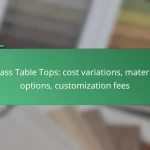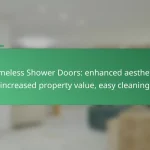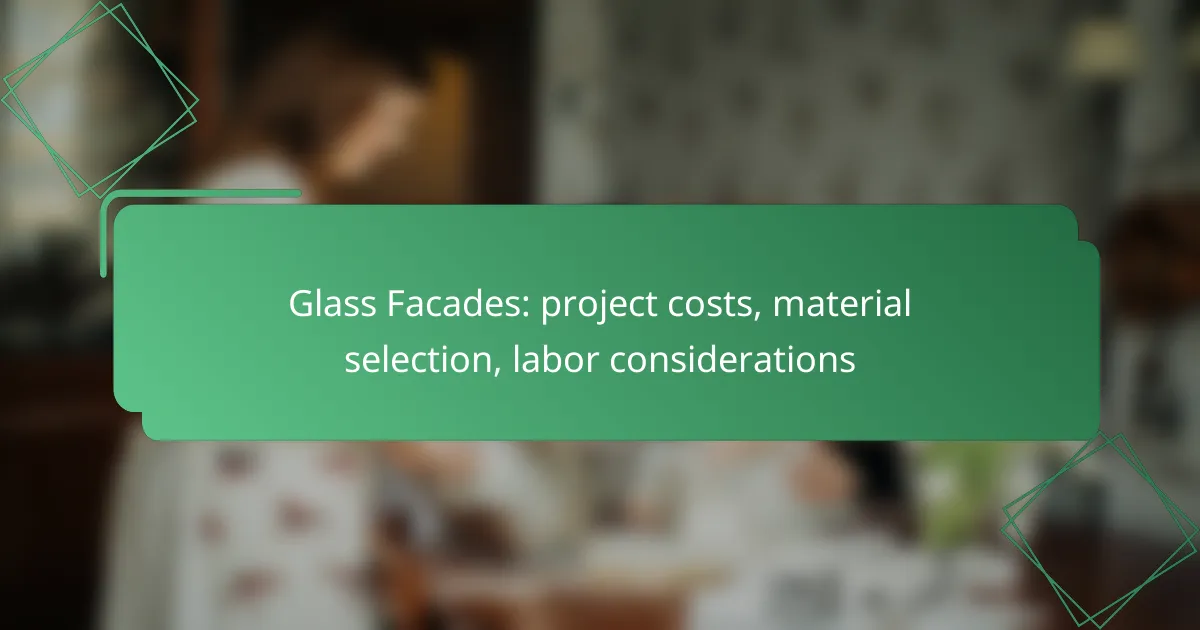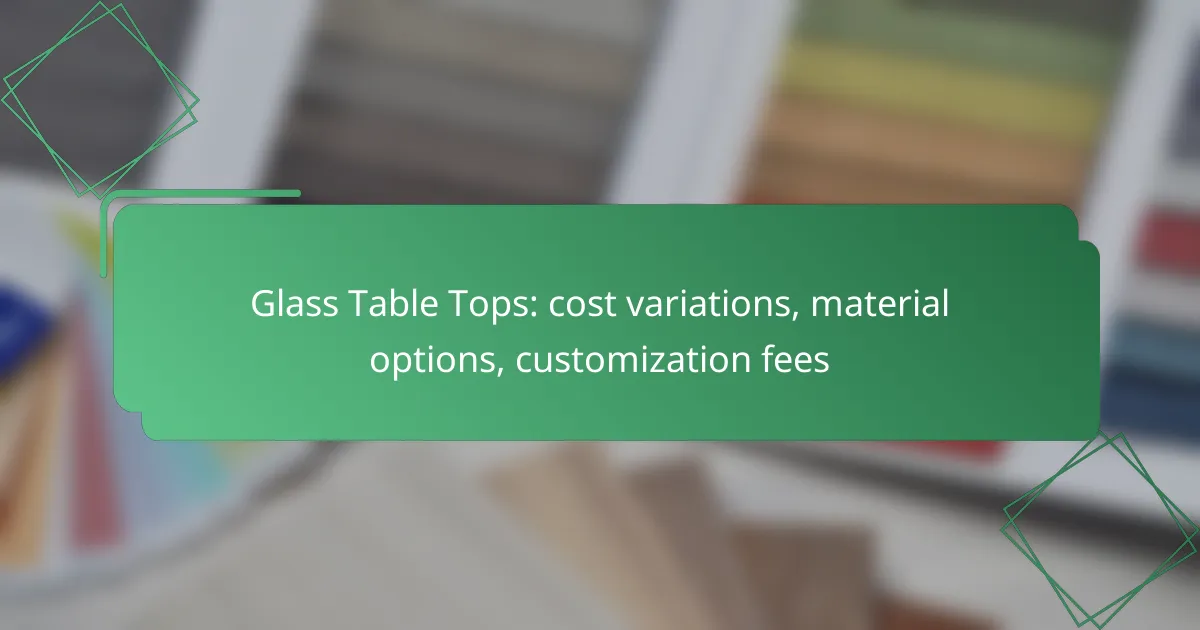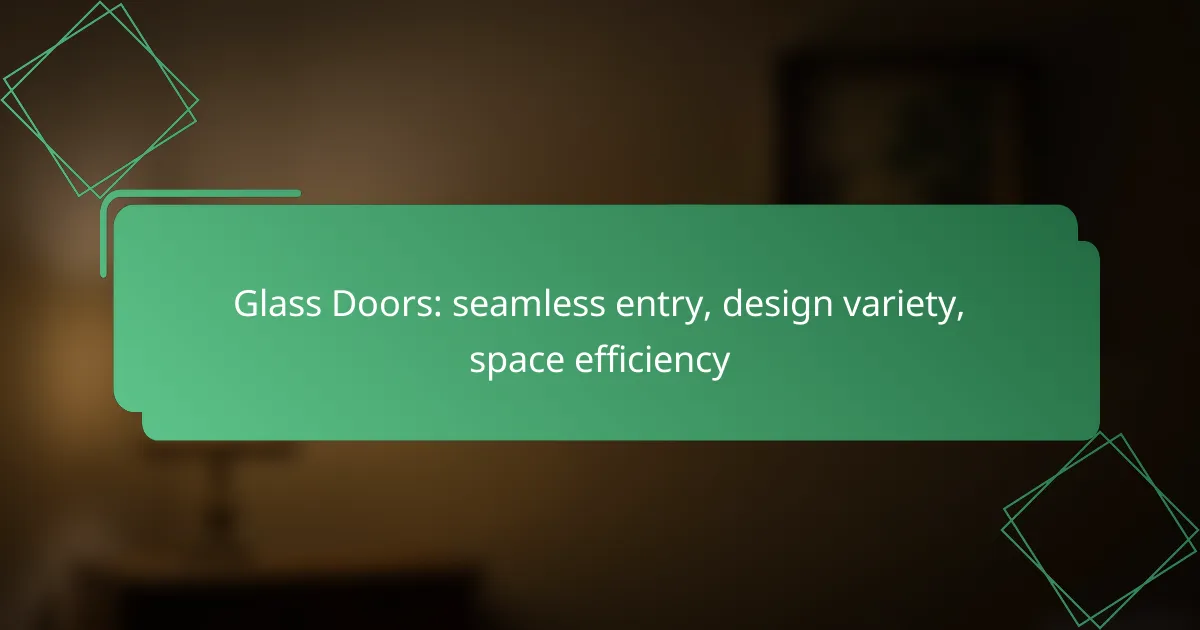Glass facades are a popular choice in modern architecture, with project costs in Canada ranging from CAD 150 to CAD 300 per square foot. The selection of materials, including various types of glass and framing systems, is critical for achieving both aesthetic appeal and structural integrity. Additionally, considerations such as climate and energy efficiency are essential in ensuring the facade meets the desired functional and visual standards.
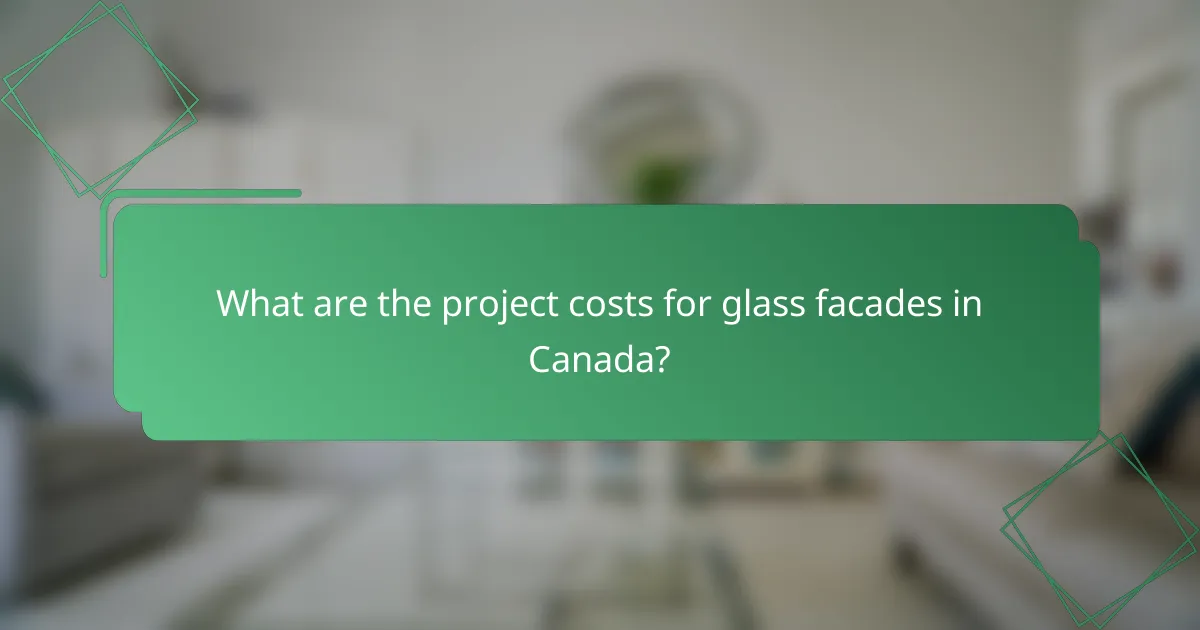
What are the project costs for glass facades in Canada?
The project costs for glass facades in Canada typically range from CAD 150 to CAD 300 per square foot, depending on various factors such as material choice and installation complexity. Understanding these costs is essential for budgeting and planning any construction or renovation project involving glass facades.
Average installation costs per square foot
The average installation costs for glass facades in Canada generally fall between CAD 150 and CAD 300 per square foot. This range can vary based on the type of glass used, the design complexity, and the building’s location. For instance, high-performance glass or custom designs may push costs toward the higher end of this spectrum.
Additionally, costs may include expenses related to structural support, insulation, and energy efficiency features. It is advisable to obtain multiple quotes from contractors to ensure competitive pricing.
Factors influencing project costs
Other considerations include the building’s height and accessibility, which can complicate installation and increase labor costs. Local regulations and permits may also affect the budget, so it is essential to factor in these potential expenses early in the planning process.
Cost comparison with other facade types
When comparing glass facades to other facade types, such as brick or concrete, glass tends to be more expensive. Traditional materials like brick may range from CAD 100 to CAD 200 per square foot, making them a more budget-friendly option for some projects.
However, glass facades offer unique advantages, such as enhanced natural light and modern aesthetics, which can justify the higher costs in certain applications. Ultimately, the choice between glass and other materials should consider both budget constraints and design goals.
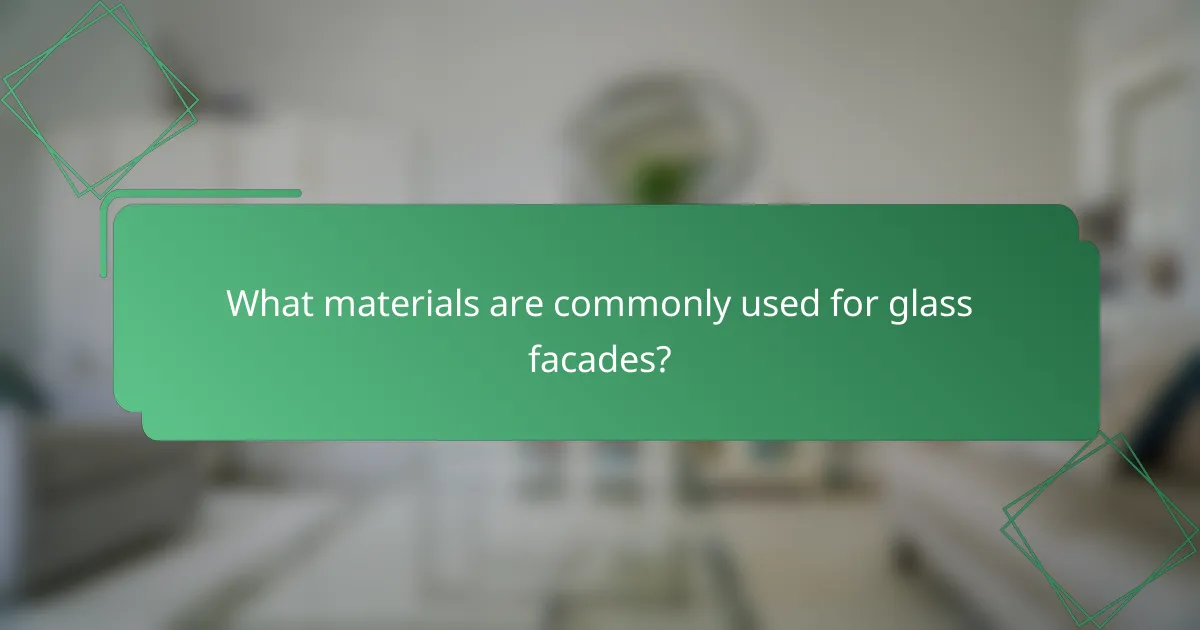
What materials are commonly used for glass facades?
Glass facades typically utilize a variety of materials designed for aesthetic appeal and structural integrity. Common materials include different types of glass, framing systems, and insulation components that work together to enhance energy efficiency and durability.
Types of glass used in facades
The most common types of glass used in facades are float glass, laminated glass, and insulated glass units (IGUs). Float glass is standard for its clarity and smooth finish, while laminated glass offers added safety and sound insulation due to its layered construction. IGUs, which consist of two or more glass panes separated by a spacer, provide excellent thermal performance.
Architects often choose glass types based on the building’s design and environmental requirements. For instance, low-iron glass is preferred for its superior transparency, making it ideal for high-end applications where clarity is paramount.
Benefits of low-E glass
Low-emissivity (low-E) glass is designed to reflect infrared energy while allowing visible light to pass through. This feature significantly enhances energy efficiency by reducing heat transfer, which can lead to lower heating and cooling costs. Buildings with low-E glass can maintain comfortable indoor temperatures year-round.
Additionally, low-E glass helps minimize UV radiation exposure, protecting interior furnishings from fading. This makes it a smart choice for commercial buildings and residential homes alike, where both energy savings and aesthetic preservation are priorities.
Durability of tempered glass
Tempered glass is known for its strength and safety, making it a popular choice for facades. It undergoes a heating and cooling process that increases its resistance to impact and thermal stress. This durability is crucial in areas prone to severe weather conditions or high foot traffic.
In case of breakage, tempered glass shatters into small, blunt pieces rather than sharp shards, reducing the risk of injury. This safety feature, combined with its structural integrity, makes tempered glass a reliable option for modern architectural designs.

How to choose the right glass facade for a project?
Choosing the right glass facade involves evaluating factors such as climate, architectural style, and energy efficiency. Each of these elements plays a crucial role in ensuring the facade meets both aesthetic and functional requirements.
Considerations for climate in Canada
In Canada, the climate can vary significantly from region to region, influencing the choice of glass facade materials. For colder areas, insulated glazing units with low-emissivity (low-E) coatings are advisable to minimize heat loss and enhance energy efficiency.
In contrast, regions with milder climates may benefit from solar control glass to reduce heat gain during warmer months. It’s essential to consider local weather patterns, including snow loads and wind resistance, when selecting materials.
Architectural style compatibility
The glass facade should complement the overall architectural style of the building. Modern designs often favor large glass panels for a sleek look, while traditional styles may require more intricate framing or smaller panes to maintain historical accuracy.
Consider the surrounding environment and existing structures to ensure harmony in design. Utilizing different glass types, such as frosted or tinted glass, can also enhance aesthetic appeal while providing necessary privacy or glare reduction.
Energy efficiency ratings
Energy efficiency ratings are critical when selecting a glass facade, as they impact both operational costs and environmental sustainability. Look for facades that meet or exceed local energy codes, such as the National Energy Code of Canada for Buildings (NECB).
Common ratings include the Solar Heat Gain Coefficient (SHGC) and the U-factor, which indicate how well the glass insulates and controls heat transfer. Choosing glass with a low U-factor and an appropriate SHGC can significantly reduce heating and cooling expenses over time.
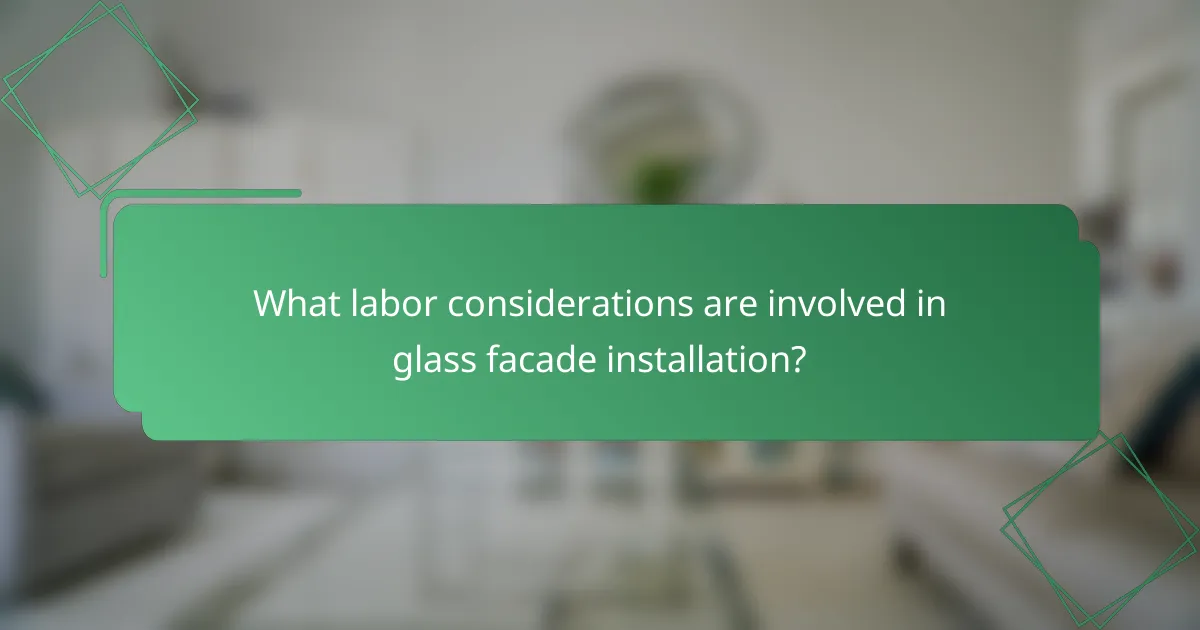
What labor considerations are involved in glass facade installation?
Labor considerations for glass facade installation include the need for skilled workers, adherence to safety regulations, and careful planning of the installation timeline. These factors significantly influence the overall project cost and efficiency.
Skilled labor requirements
Installing glass facades requires specialized skills, including knowledge of structural engineering and experience with glass handling. Workers must be trained in techniques for safely lifting and securing large glass panels, often using cranes or scaffolding. Hiring experienced professionals can help mitigate risks and ensure a high-quality installation.
In many regions, certifications or licenses may be required for workers involved in glass installation. It is advisable to verify the qualifications of contractors and their teams to ensure compliance with local standards.
Safety regulations for installation
Safety regulations for glass facade installation are critical to protect workers and the public. These regulations often include guidelines for personal protective equipment (PPE), fall protection systems, and proper handling of glass materials. Compliance with Occupational Safety and Health Administration (OSHA) standards in the U.S. or equivalent local regulations is essential.
Regular safety training sessions should be conducted to keep the installation team updated on best practices and new safety protocols. Failure to adhere to these regulations can lead to accidents and costly delays.
Timeline for installation phases
The timeline for glass facade installation can vary based on project size and complexity, typically ranging from a few weeks to several months. Key phases include site preparation, glass panel fabrication, and final installation. Each phase should be carefully scheduled to minimize downtime and ensure smooth transitions between tasks.
Delays can occur due to weather conditions or supply chain issues, so it’s wise to build in buffer time within the project schedule. Clear communication with all stakeholders can help keep the project on track and address any potential issues promptly.

What are the maintenance requirements for glass facades?
Glass facades require regular maintenance to ensure their aesthetic appeal and structural integrity. Key maintenance tasks include cleaning, inspection, and addressing any damage promptly to prolong the lifespan of the facade.
Cleaning protocols for glass surfaces
Cleaning glass surfaces is essential to maintain clarity and prevent deterioration. A typical cleaning schedule may involve biannual deep cleaning, with more frequent touch-ups in urban areas where pollution is higher. Use non-abrasive cleaners and soft cloths to avoid scratching the glass.
Consider using water-fed pole systems for high-rise buildings, which can safely reach elevated surfaces without scaffolding. Always check local regulations regarding the use of chemicals to ensure compliance with environmental standards.
Inspection schedules for structural integrity
Regular inspections are crucial for assessing the structural integrity of glass facades. A common practice is to conduct inspections at least once a year, focusing on seals, frames, and any signs of stress or damage. Early detection of issues can prevent costly repairs later.
During inspections, look for cracks, sealant degradation, and any displacement of the glass panels. Document findings and address any necessary repairs immediately to maintain safety and performance standards.
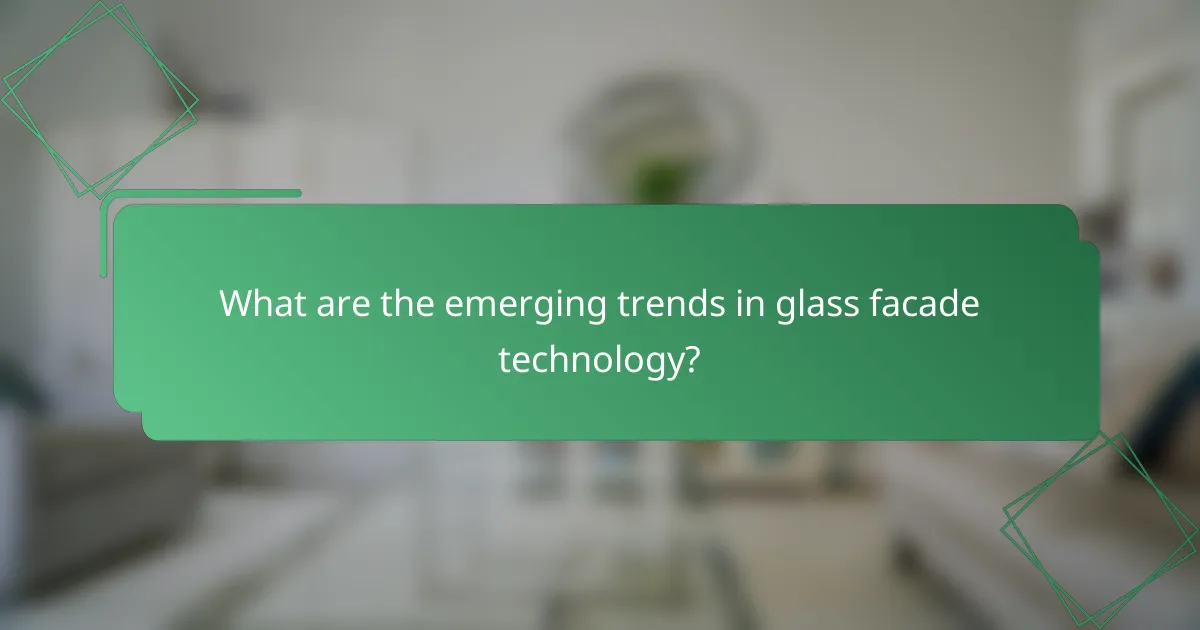
What are the emerging trends in glass facade technology?
Emerging trends in glass facade technology focus on enhancing energy efficiency, aesthetics, and sustainability. Innovations include smart glass that adjusts to environmental conditions and the use of eco-friendly materials that reduce carbon footprints.
Project costs
Project costs for glass facades can vary significantly based on design complexity, material selection, and installation requirements. Generally, budgets may range from several hundred to several thousand USD per square meter, depending on factors like the type of glass and structural support needed.
It’s essential to consider both initial costs and long-term savings from energy efficiency. Investing in high-performance glass may result in higher upfront costs but can lead to reduced energy bills and maintenance over time.
Material selection
Choosing the right materials for glass facades is crucial for performance and aesthetics. Options include tempered glass, laminated glass, and low-emissivity (Low-E) glass, each offering different benefits in terms of safety, insulation, and UV protection.
When selecting materials, consider local climate conditions and building regulations. For example, Low-E glass is often preferred in regions with extreme temperatures as it enhances thermal performance and reduces energy consumption.
Labor considerations
Labor considerations for installing glass facades involve skilled labor for both fabrication and installation. Specialized teams are often required to ensure safety and precision, particularly for large or complex installations.
It’s advisable to engage contractors with experience in glass facade projects to avoid common pitfalls, such as improper sealing or structural support issues. Proper training and safety measures are essential to mitigate risks during installation.
